Experience the Breathtaking Winter Scenery in the Niigata-Tohoku Area
Japan is a country where you can see beautiful natural landscapes throughout the four seasons. Especially in winter, various regions in Tohoku and Niigata are adorned with majestic natural beauty, as they are covered in a pure white veil of snow. In addition to the accumulating snow, the artistry of snow and ice, nurtured by the harsh cold and unique natural conditions, also adds a special touch to the winter scenery.
In Tohoku and Niigata, there are numerous activities to enjoy the unique winter scenery. These views cannot be seen once the snow and ice melt in spring. It is precisely because they can only be encountered at this time and in this place that their beauty stands out even more, evoking emotions that cannot be experienced in other seasons.
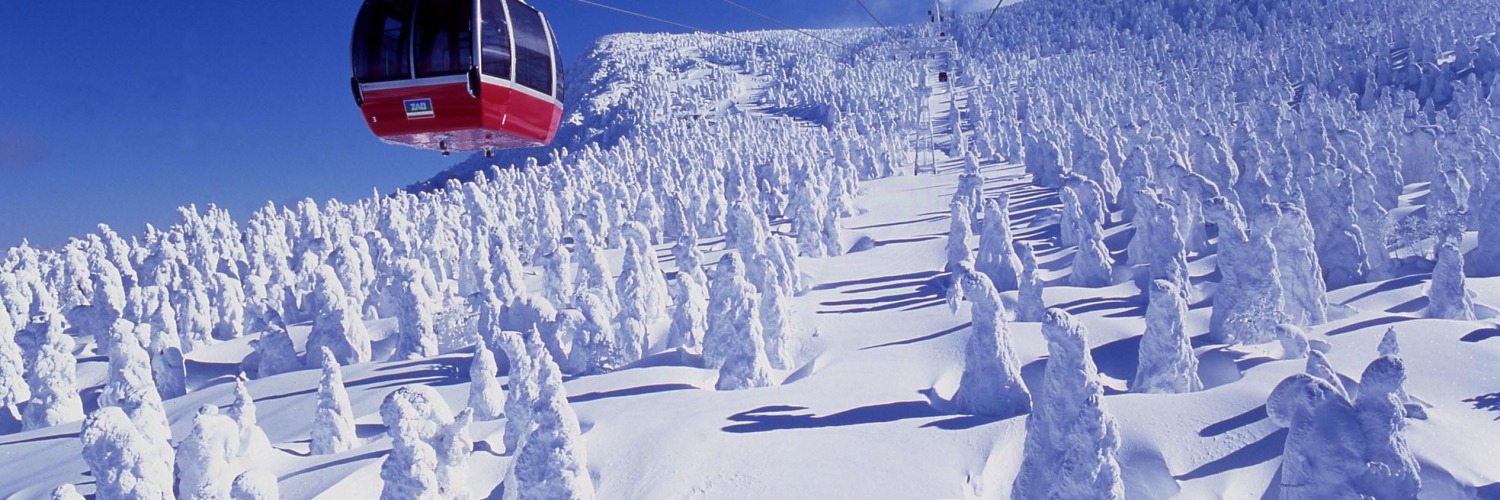
Winter-Exclusive View! Witness the Nanataki Frozen Falls From Directly Below the Waterfall Basin
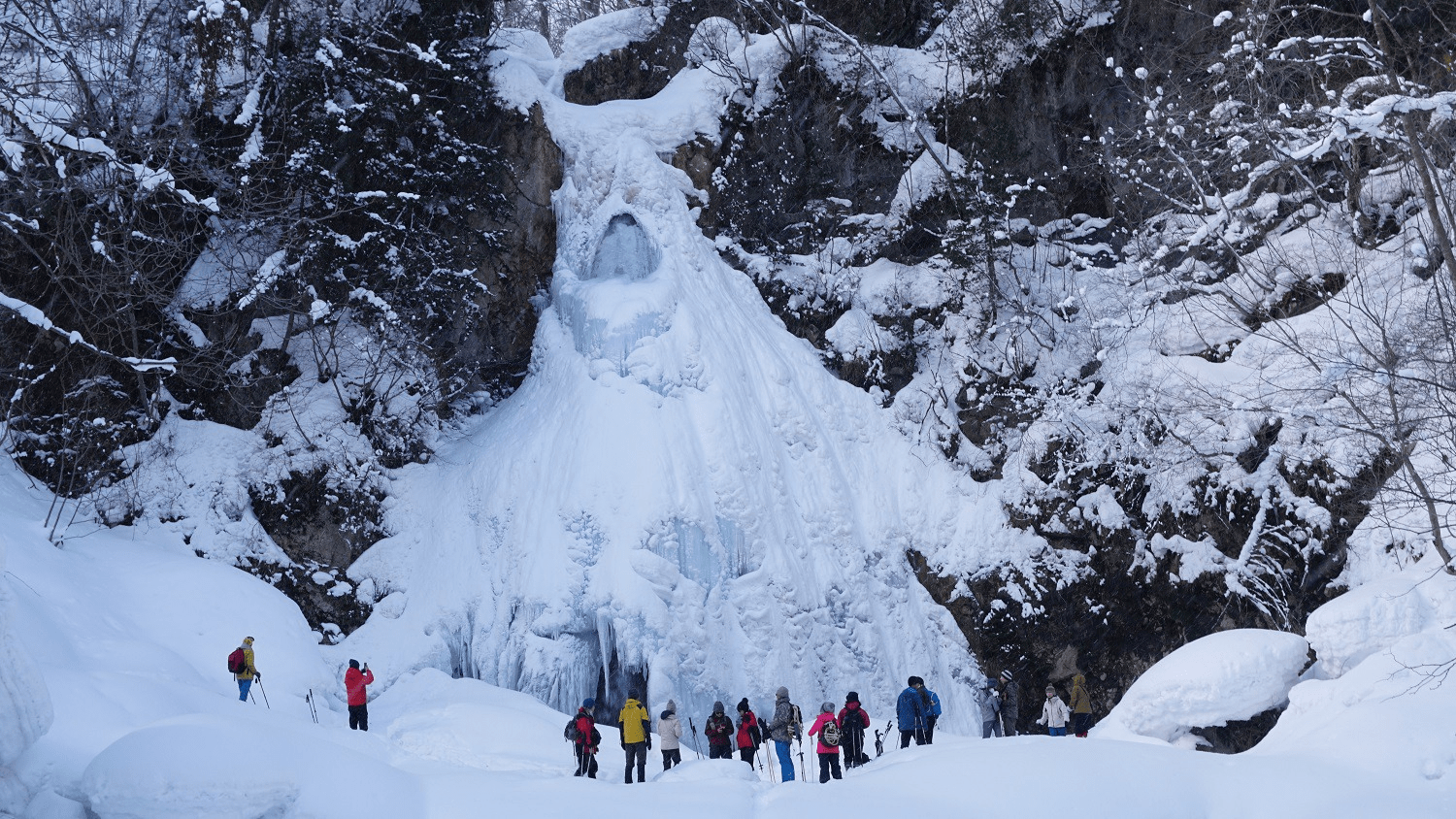
The vast plateau of Hachimantai, spanning across Iwate and Akita prefectures, is formed by a series of mountains centered around the 1,613-meter-high peak of Mt. Hachimantai. This tourist attraction offers beautiful landscapes throughout the seasons, including the mystical sight of snow melting in spring (known as "Hachimantai Dragon Eye"), alpine plants in summer, autumn foliage in fall, and snowy scenery in winter.
During the winter season, you can witness breathtaking scenery that is nurtured by the harsh cold. One of these sights is the "frozen falls," where the water flowing from the waterfall freezes upon contact with the outside air. In Hachimantai, you can admire the Nanataki Frozen Falls, a 25-meter-tall waterfall located in a stream flowing from Mt. Iwate.
As water falls from the mouth of the waterfall and freezes in the process, the frozen falls retain the shape of the flowing water. The ice columns spreading like a fan towards the basin shine in a pale blue color, creating a very mysterious atmosphere. Observing this scenery, you can experience a strange sensation as if time has come to a standstill despite the dynamic nature of the view.
The Hachimantai Mountain Hotel organizes a snowshoe trekking tour that allows you to comfortably explore the Nanataki Frozen Falls. Snowshoes are devices that are attached to shoes or snow boots to make it easier to walk without sinking into the snow. By wearing these snowshoes, you can explore the winter forest and visit the frozen falls. Even those who are new to walking on snow can enjoy participating in this activity.
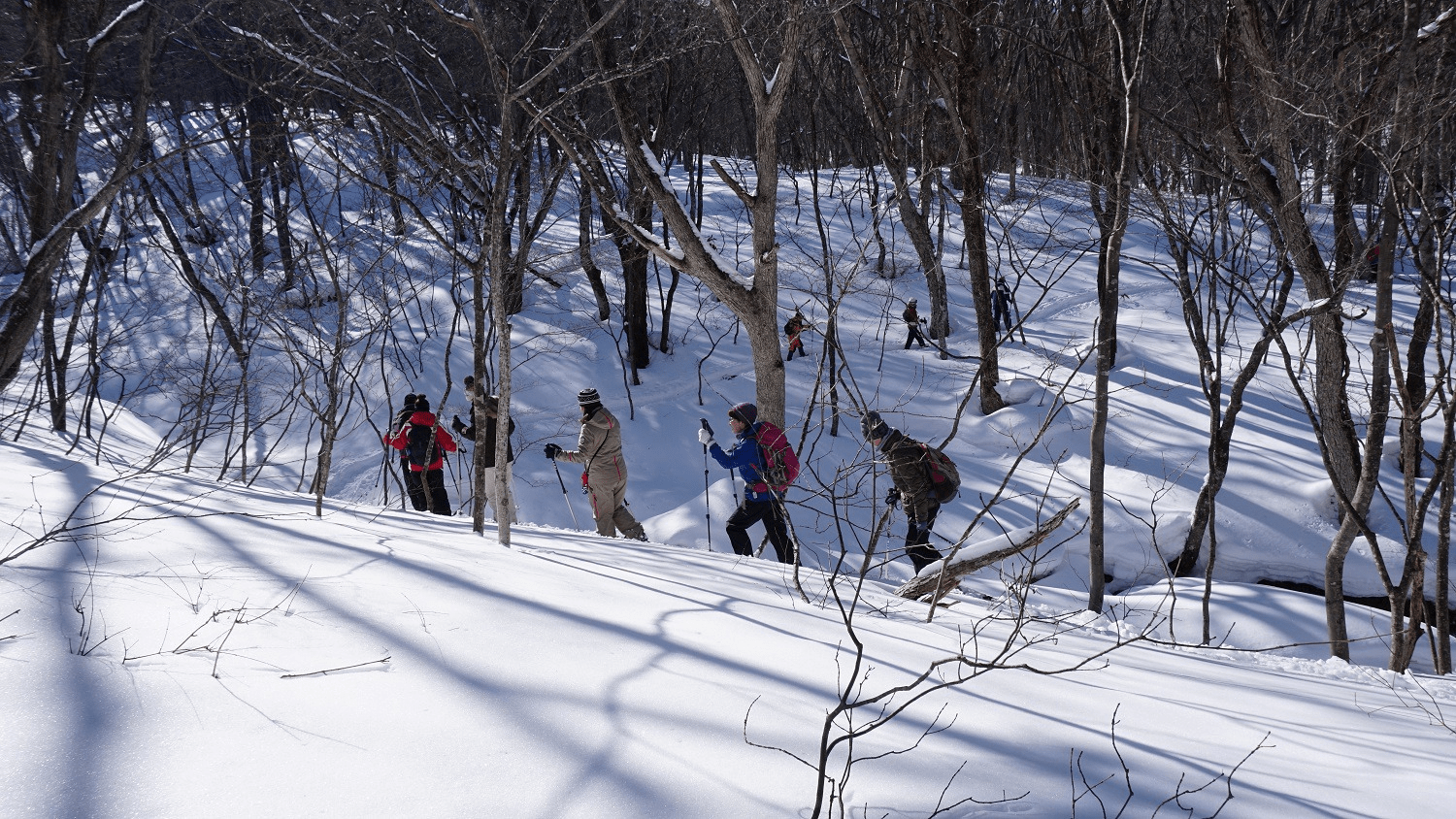
On the tour, you will first take a ride on the 4-person high-speed lift at the Panorama Ski Area adjacent to the hotel, providing easy access to the upper part of the slopes. After that, you will explore the snow-covered beech forest for about an hour with snowshoes, aiming for the frozen falls. This is a course unique to this season, as it is not accessible in the summer.
In this guided walk, led by a knowledgeable guide familiar with the area, you can see the footprints of animals such as rabbits and squirrels that remain on the snow and encounter winter buds waiting for spring. There are plenty of discoveries that you won't find during the season for greenery! After completing the walk and reaching the frozen falls, make sure to approach the basin to fully appreciate its breathtaking beauty. Even if you don't have your own equipment, you can rent snowshoes, shoes, poles, and more for the tour, so there's no need to worry.
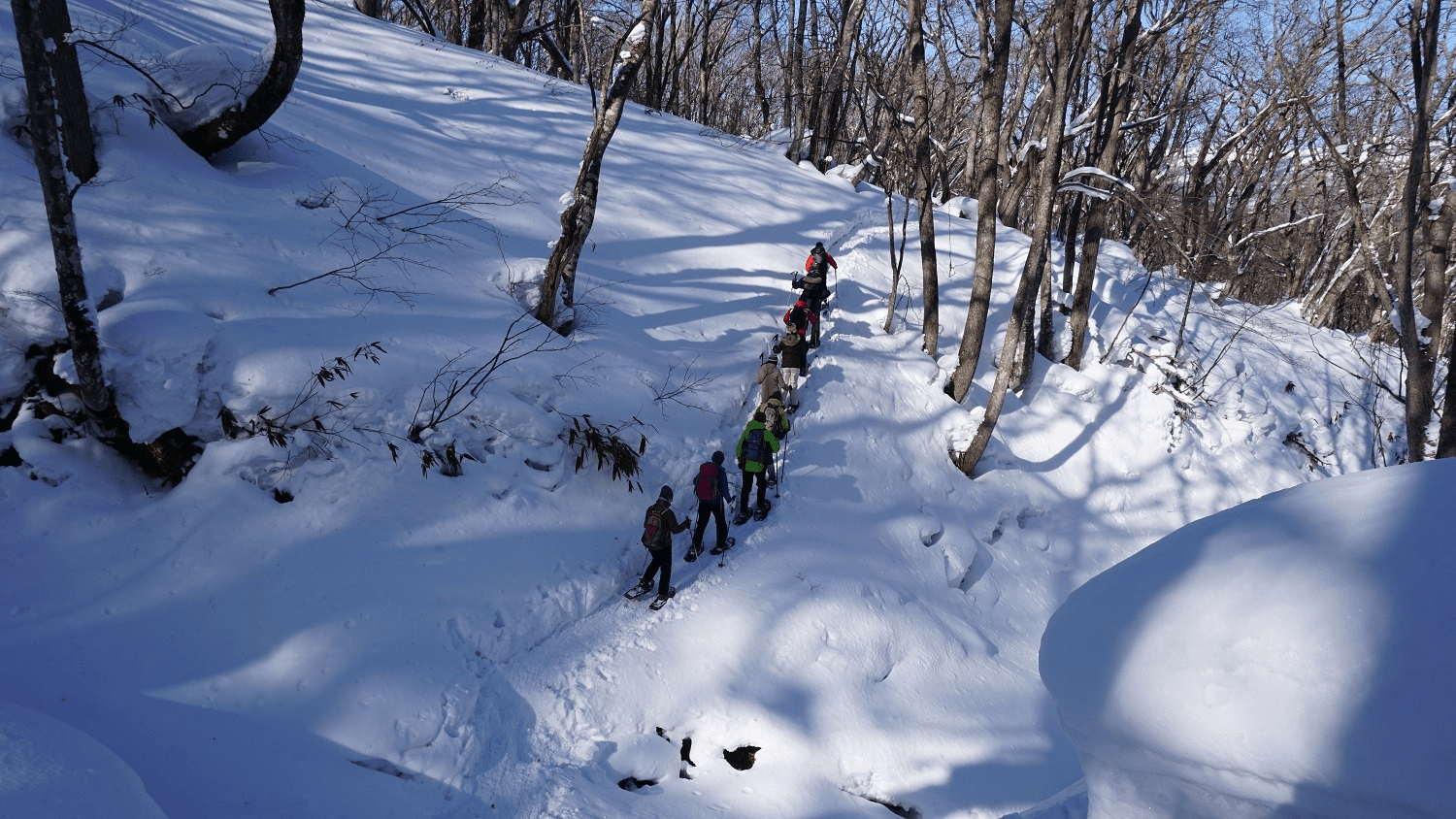
The Nanataki Frozen Falls begins to freeze around mid-January each year and reaches its peak from late January to mid-February. One of its attractions is that depending on the weather conditions of the year, the entire area of the waterfall may be frozen over, or both the frozen and flowing portions of the waterfall can be seen. This allows you to enjoy different scenery every year.
After delighting in the beauty of the frozen falls and receiving a mood boost, it's suggested to further relax by warming your body in the hot springs flowing in Hachimantai. In the vicinity of the Nanataki Frozen Falls, there are day-trip hot spring facilities and hot spring inns such as the Hachimantai Onsenkyo and Matsukawa Onsen. While soaking in the warm snow-viewing baths, you can enjoy Hachimantai's pristine white landscape.
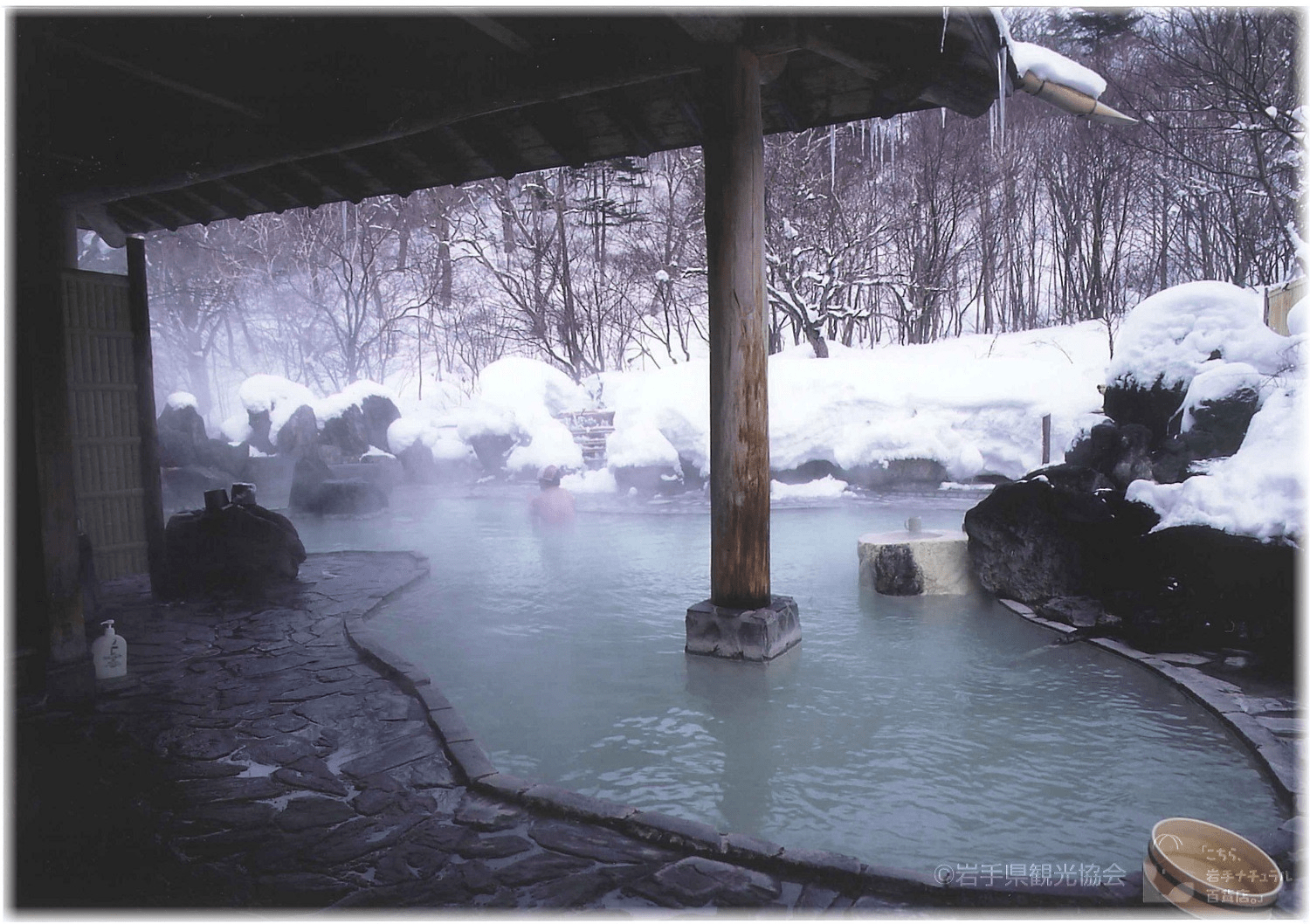
You can partake in more activities at the nearby ski resorts. The Panorama Ski Area, directly connected to the Hachimantai Mountain Hotel, which serves as the departure and arrival point for the snowshoe trekking tour, is a recommended ski resort with gentle slopes and popular long courses suitable for beginners. Additionally, the Shimokura Ski Resort, located about a 10-minute shuttle bus ride from the Panorama Ski Area, offers superb powder snow, diverse courses with varying terrain, and four tree run areas for your enjoyment.
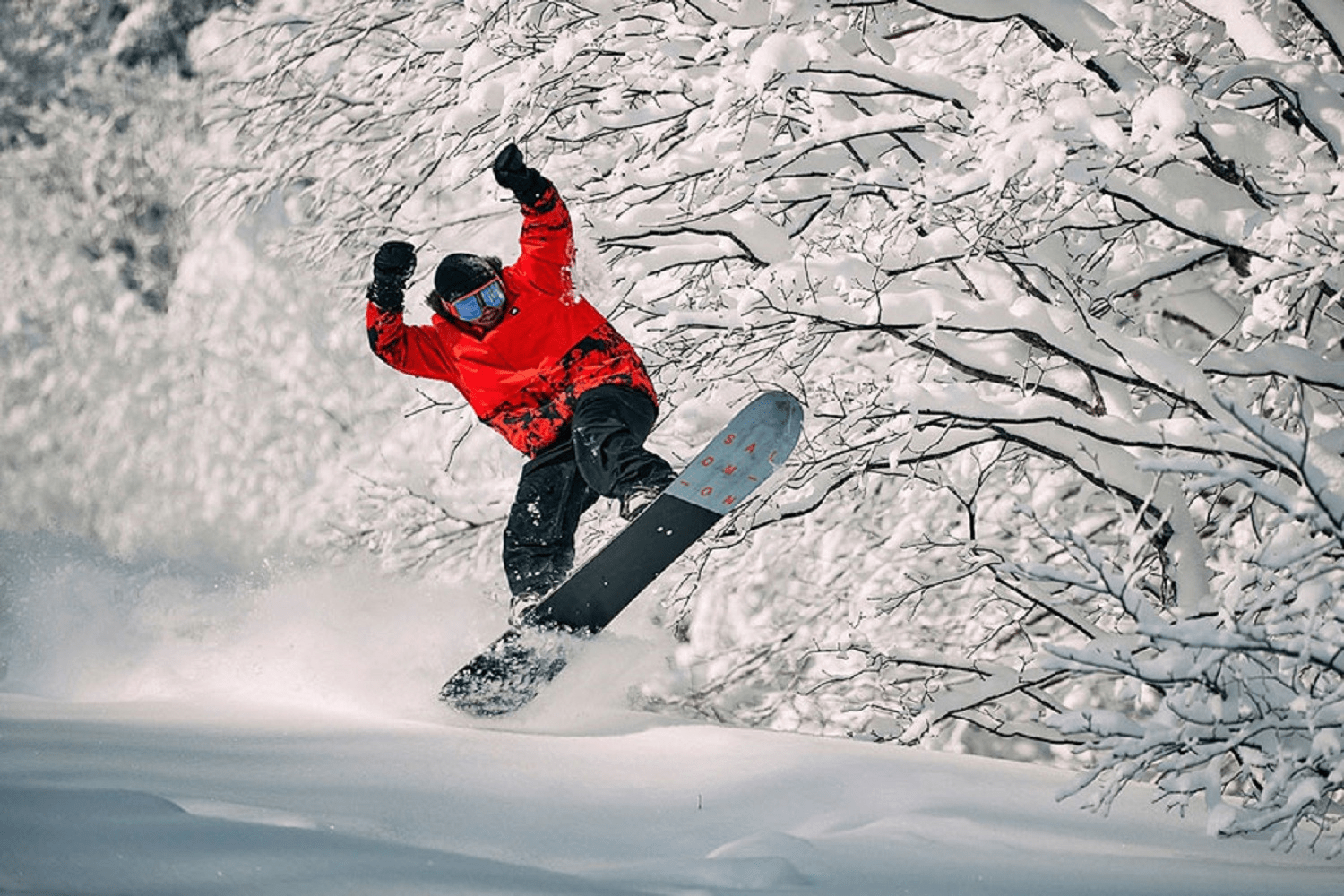
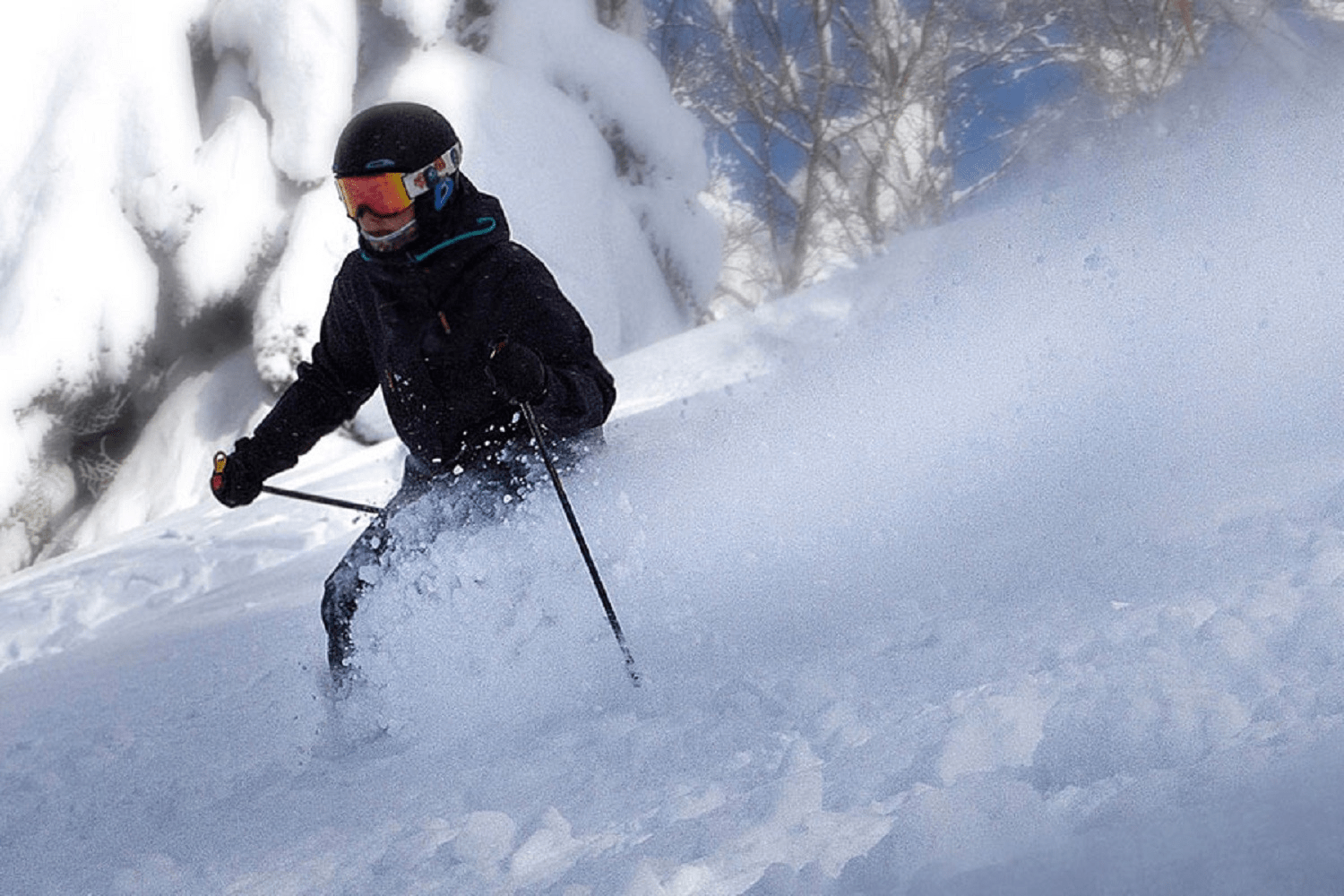
Comfortably Enjoy "Juhyo," an Exceptionally Unique Phenomenon Worldwide
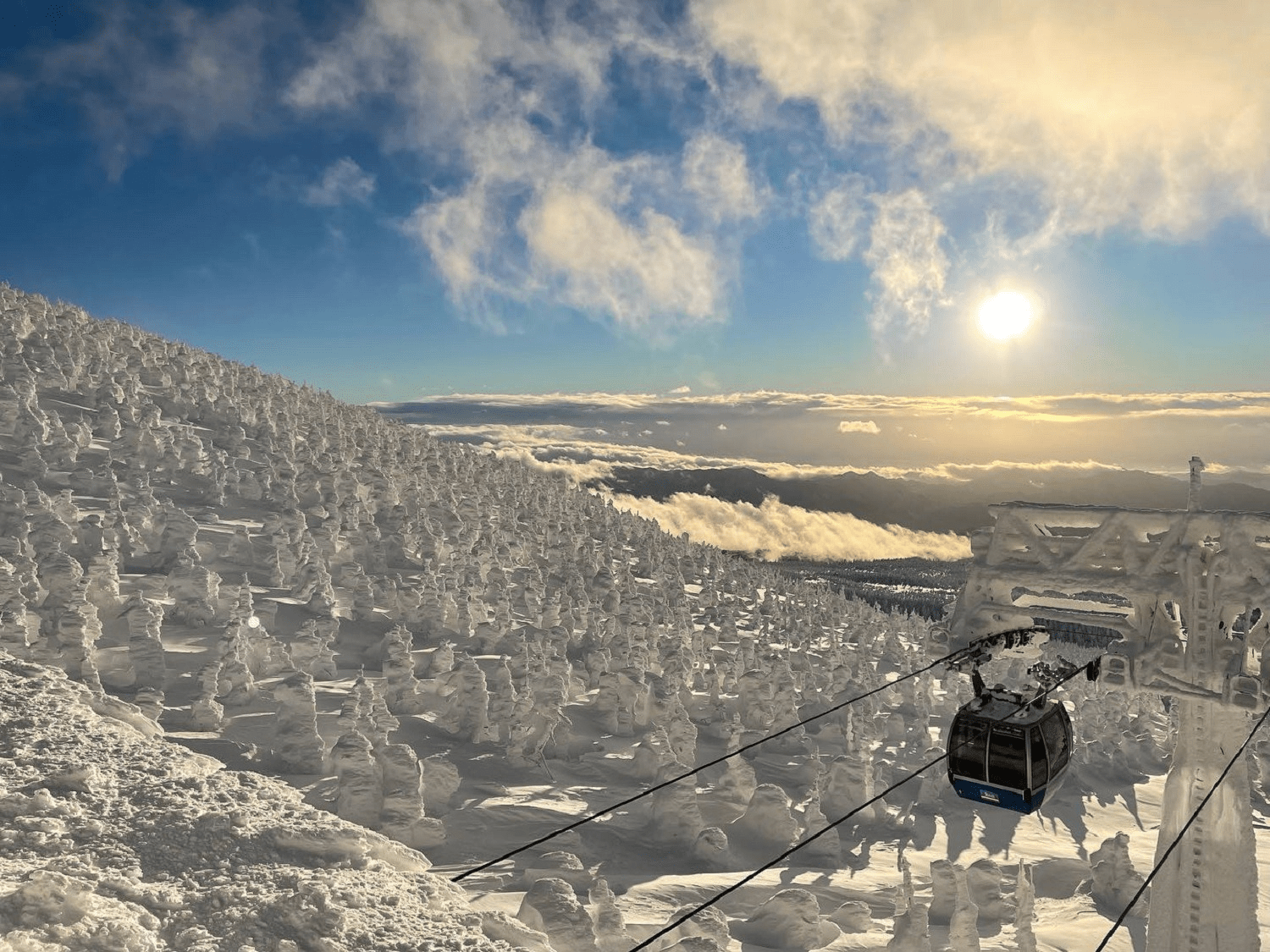
(Photo courtesy of Zao Ropeway)
In certain parts of Japan and only in a few other regions worldwide, there is a natural phenomenon called "Juhyo" (frost-covered trees). This occurs when coniferous trees and their branches are covered in snow and ice, freezing them solid. It is a very unique occurrence that requires specific conditions such as altitude, terrain, wind direction, vegetation, and snowfall volume. The sight of trees covered in snow and ice is incredibly beautiful and often referred to as a "natural work of art."
Among the regions in Japan where you can see frost-covered trees, the Zao Mountain Range spanning Yamagata and Miyagi Prefectures is known as one of the largest and most famous spots. From the summit area to the mid-slope area of the Zao Mountain Range, there is a dense forest of Oshirabiso fir trees (also known as Aomori Todomatsu) where ice and snow easily accumulate, transforming the forest into a frost-covered wonderland during winter. The view of the frost-covered trees spreading as far as the eye can see, covering the snowy landscape, is truly breathtaking! Each frost-covered tree has a unique shape, and the ones that have grown to completely cover the trees are also called "Snow Monsters" due to their distinctive appearance.
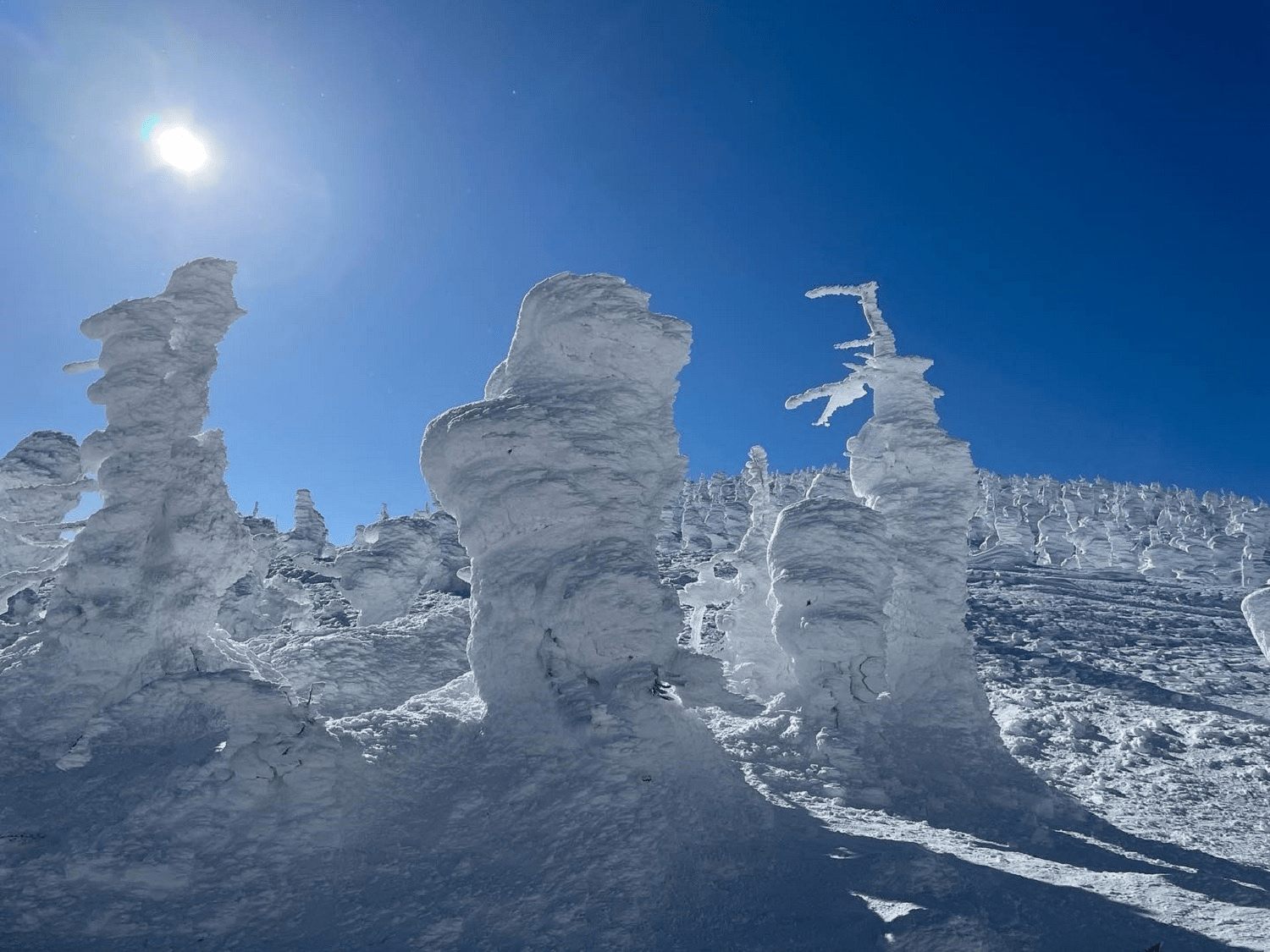
(Photo courtesy of Zao Ropeway)
The frost-covered trees of Zao can be seen from both Yamagata and Miyagi Prefectures. From the Miyagi side, you can ride a snowmobile to go see the frost-covered trees, while on the Yamagata side, there is a frost-covered tree field within the Yamagata Zao Onsen Ski Resort. Therefore, it is possible to go directly to the frost-covered tree field in about 18 minutes by transferring from Zao Sanroku Station in the foothills of Zao Onsen Town to the Zao Ropeway Sanroku Line and Sancho Line, making it the shortest route. Of course, even those who do not ski or snowboard can ride the gondola.
As you arrive at Jizo Sancho Station after descending from the ropeway, a world of silvery white unfolds before your eyes, and colossal snow monsters emerge one after another! The stunning scenery, complemented by the contrast between the blue sky and the white snow, radiates an indescribable beauty.
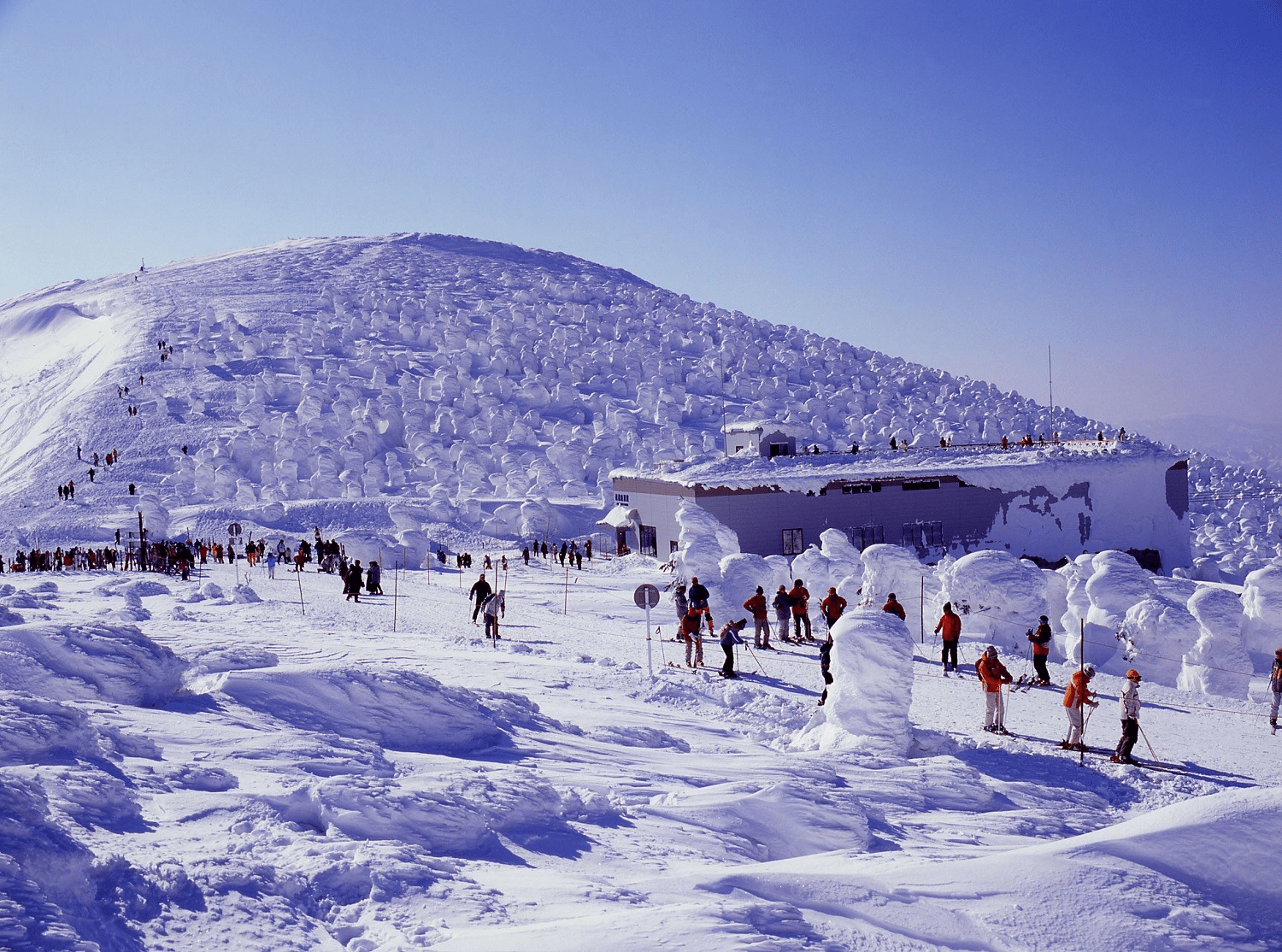
The enjoyment of viewing the frost-covered trees is not limited to natural light alone. From December to February each year, there is a nighttime illumination event featuring the frost-covered trees. In the pitch-black darkness, the frost-covered trees illuminated by vibrant cocktail lights create an even more fantastical spectacle.
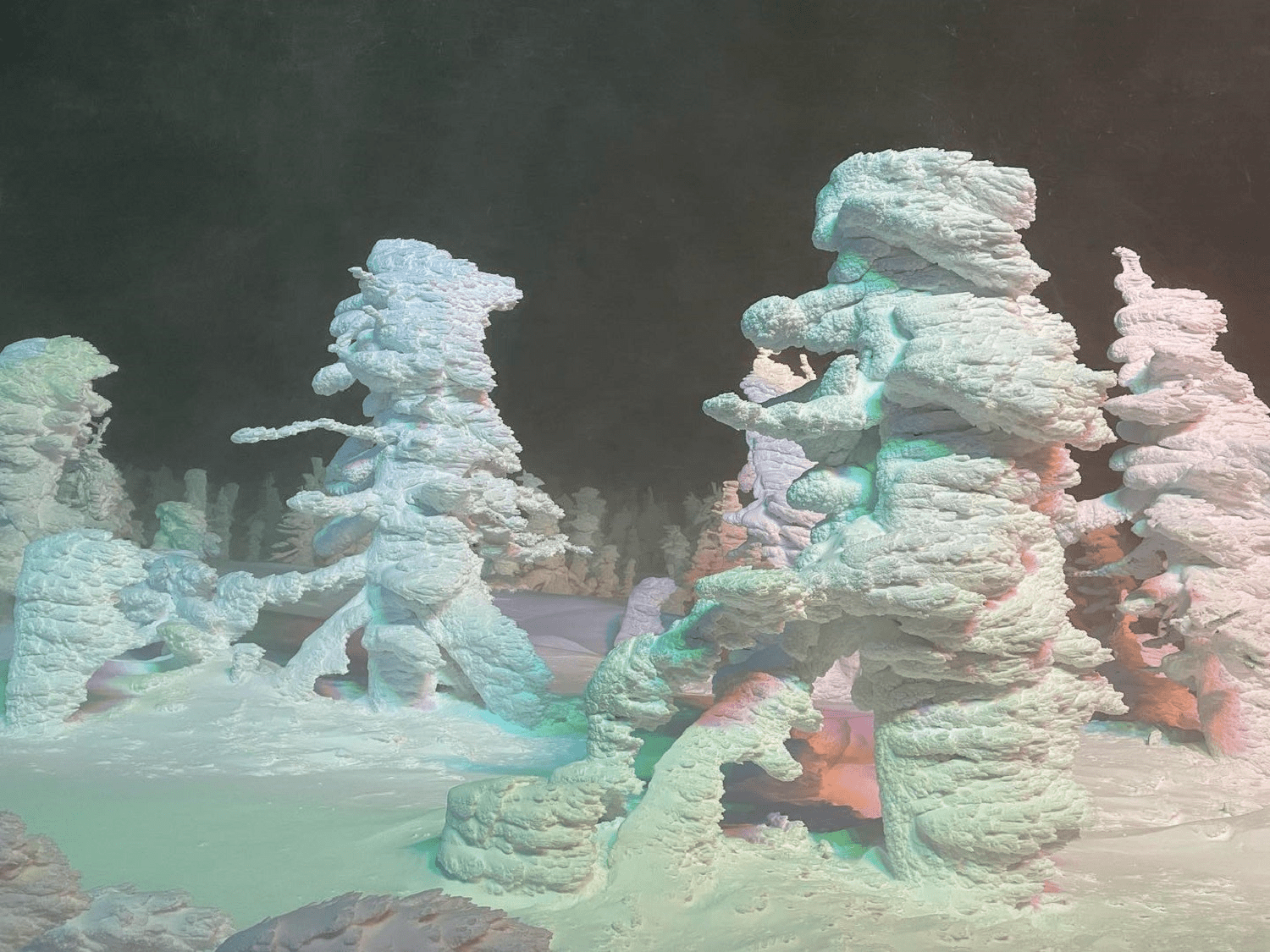
At night, there will be a guided tour for observing frost-covered trees aboard the "Night Cruiser" snowmobile. Embarking on this one-of-a-kind journey, comfortably gliding through the illuminated field of frost-covered trees on a newly designed snowmobile with heating is an exceptional experience!
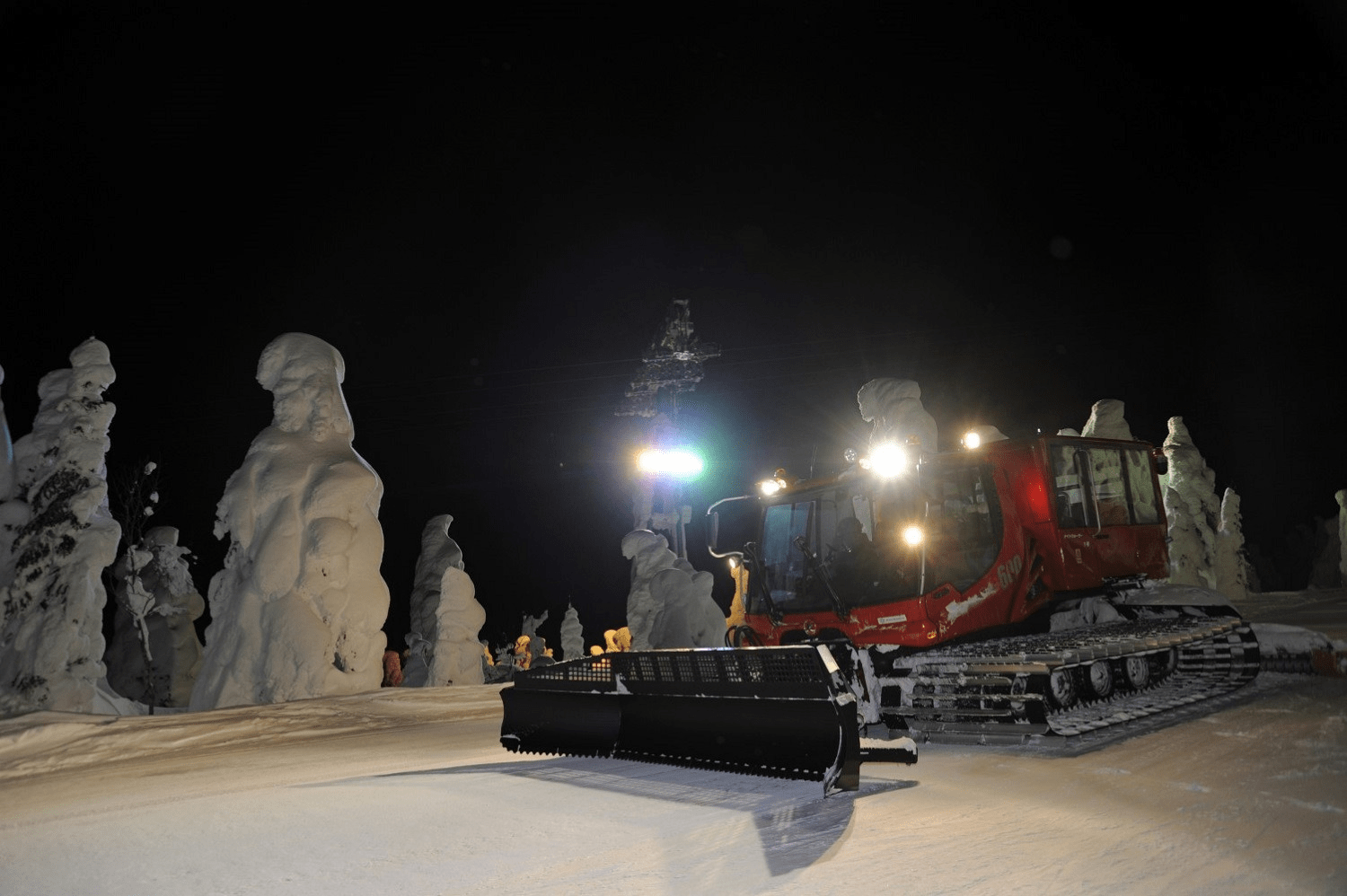
The best time to see the frost-covered trees in Zao is usually from late December to early March, with the peak season occurring around late January to late February.
The Yamagata Zao Onsen Ski Resort, where you can see frost-covered trees, is known as one of the largest mountain resort areas in Tohoku. The ski resort boasts 14 slopes, 12 courses, and a maximum skiing distance of approximately 10 kilometers. In addition, there is a unique "Field of Frost-Covered Trees Course," where you can ski while enjoying the frost-covered trees. Skiers and snowboarders should definitely enjoy skiing on the frost-covered tree field!
Zao Onsen, which is directly connected to the ski slopes, is a lively hot spring town with inns, hotels, restaurants, and souvenir shops.
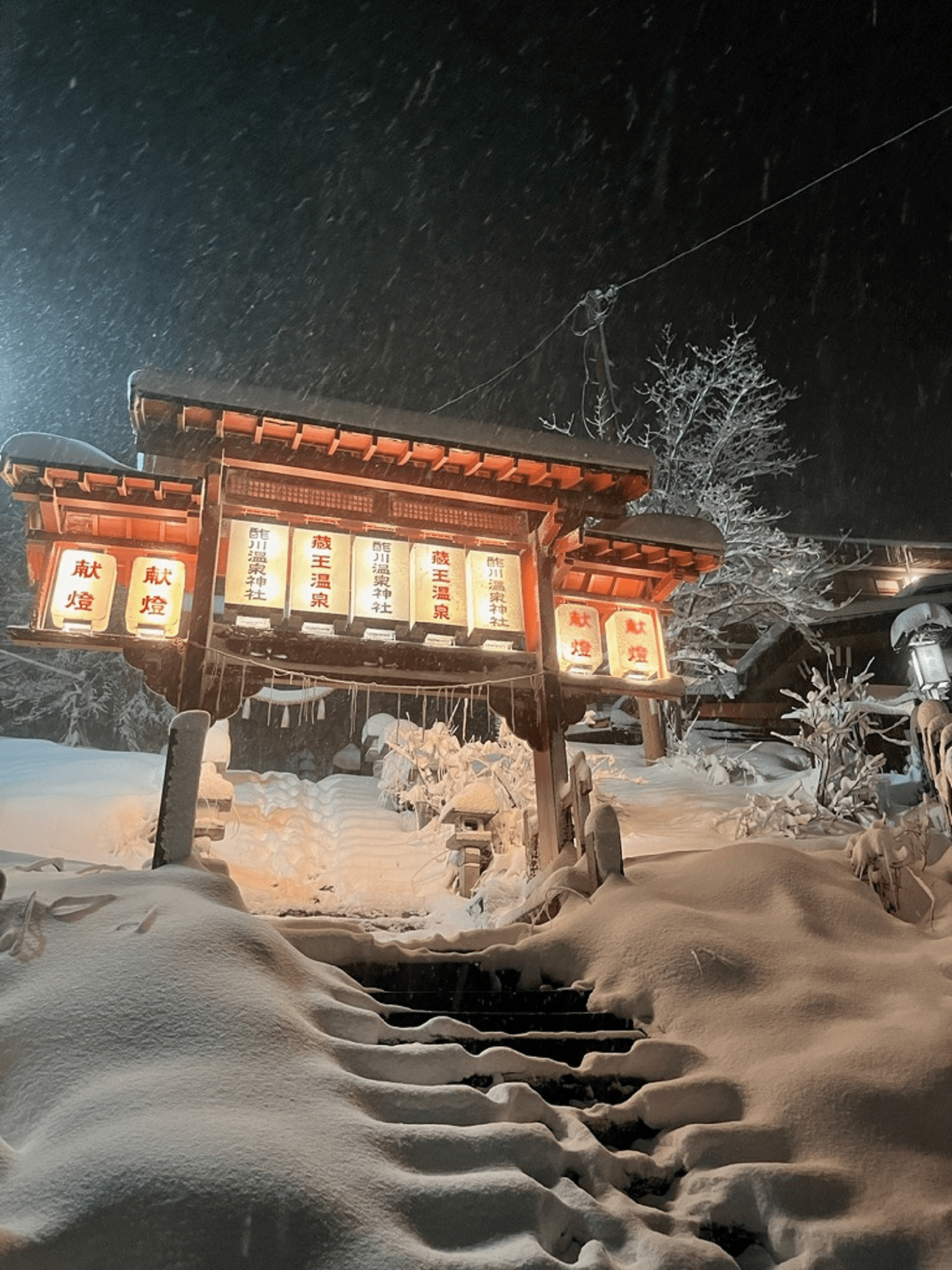
Within the hot spring town, there are three public bathhouses, three footbaths, and five day-trip hot spring facilities (three of which operate during the winter season), providing visitors with convenient access to enjoy Zao Onsen's distinctive feature—the most acidic hot spring in the Tohoku region. At the restaurants, you can savor various Yamagata delicacies, such as soba noodles, Tama Konnyaku (ball-shaped konjac), and the famous Zao Onsen specialty, Jingisukan (mutton/lamb BBQ).
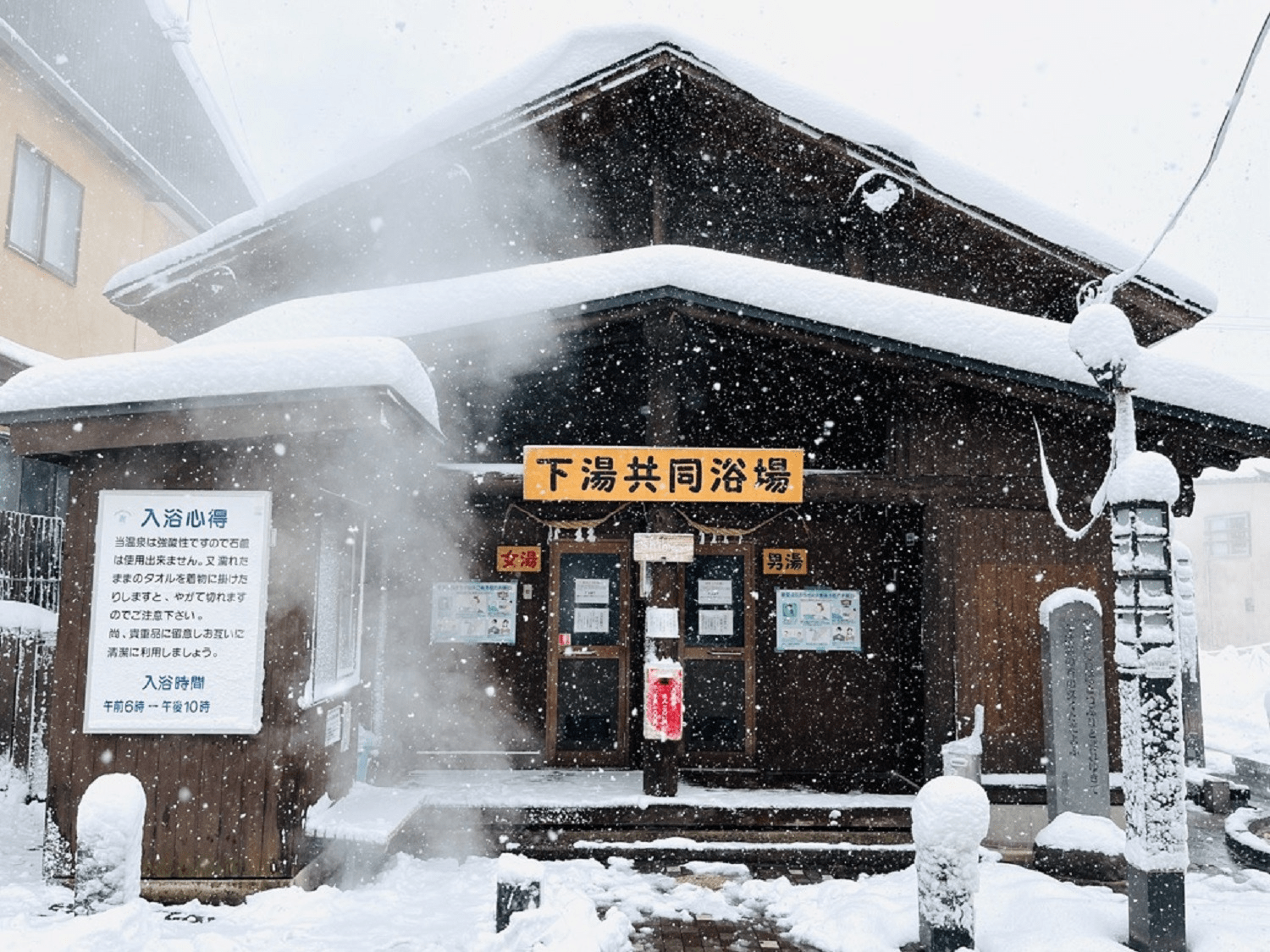
While the primary goal may be appreciating the frost-covered trees, Zao Onsen in Yamagata offers an array of attractions, from skiing, snowboarding, and hot springs to delicious cuisine.
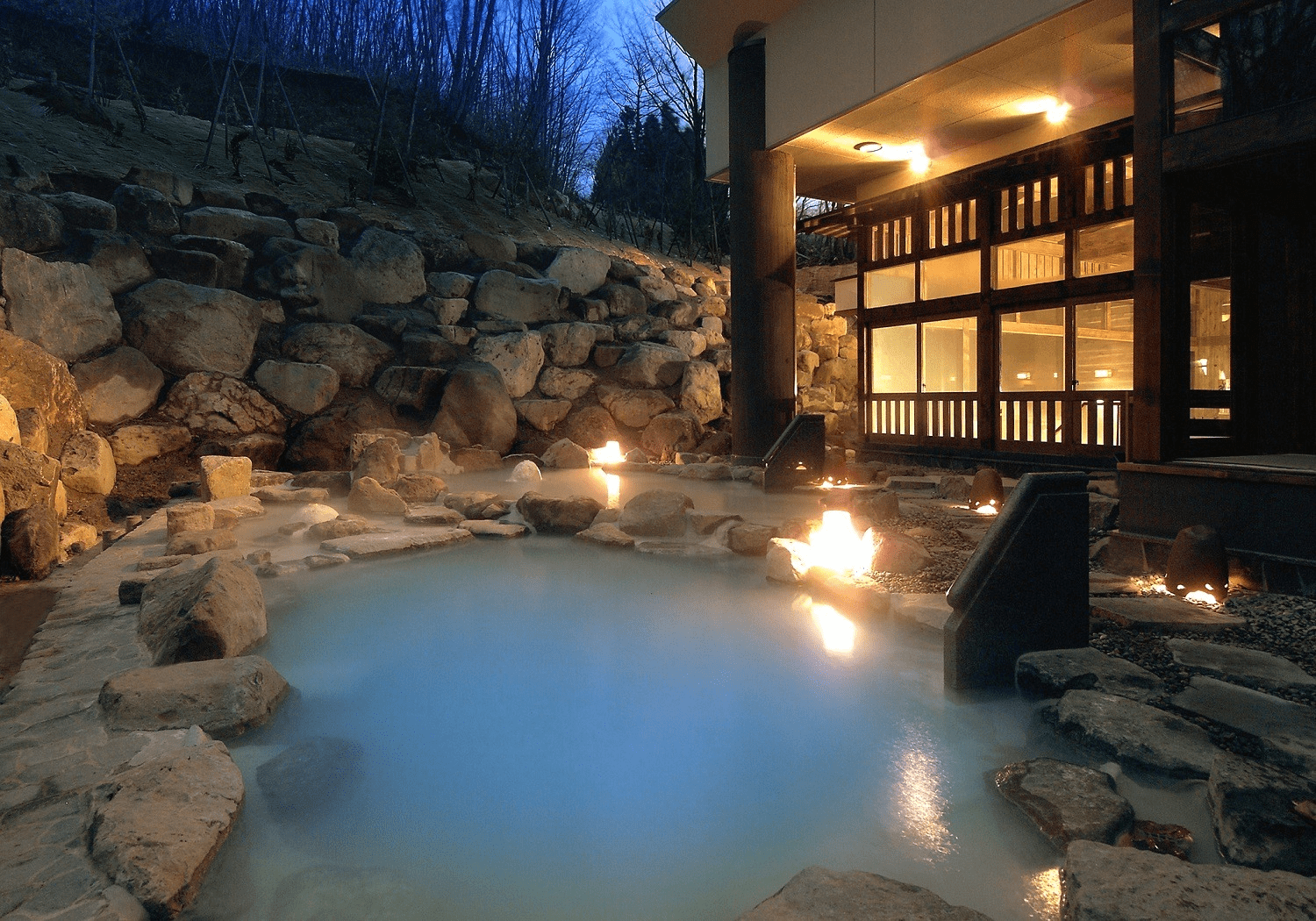
Kiyotsu Gorge, Where the Beauty of Natural Sculptures Converges With Modern Art
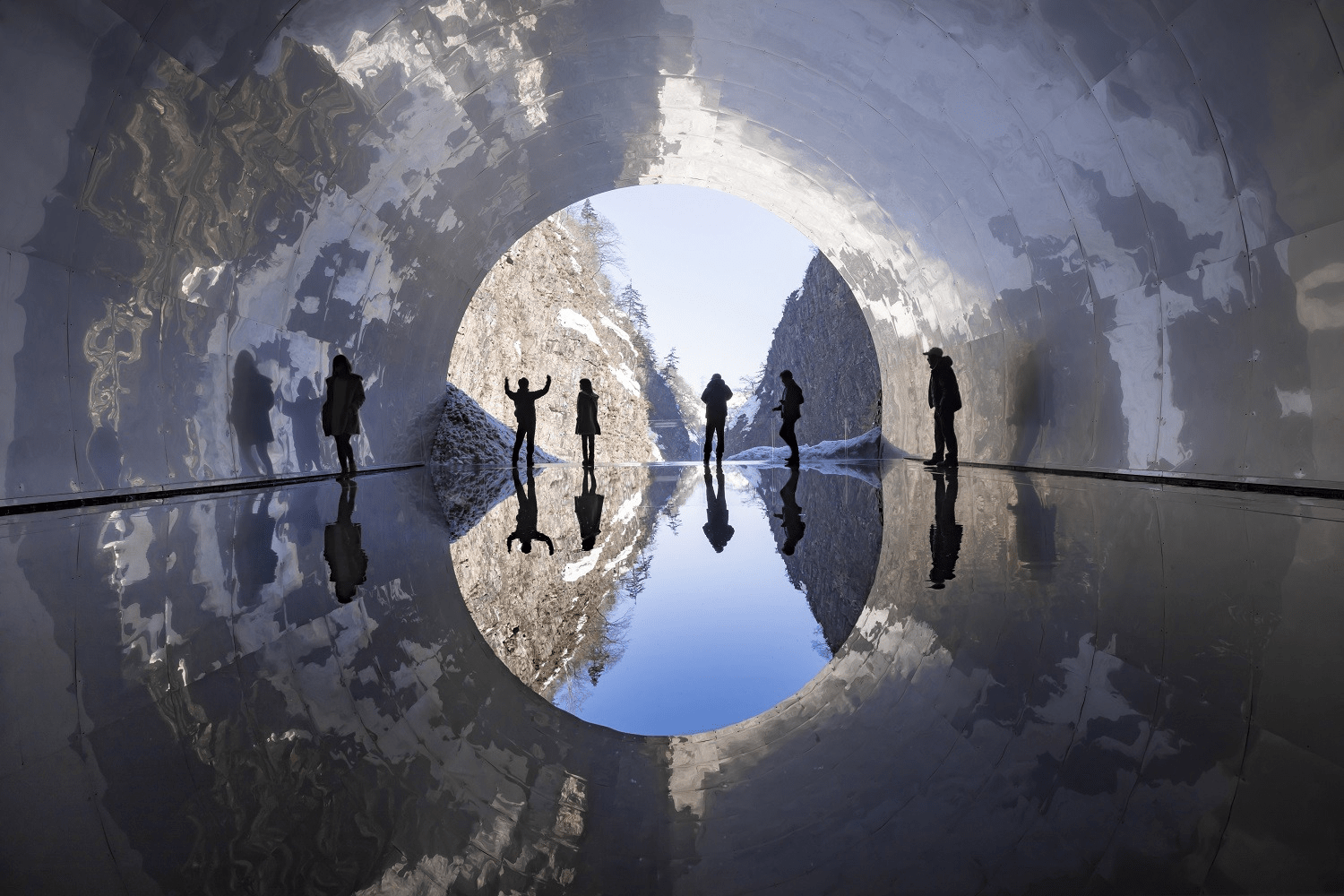
photos: Ma Yansong/MAD Architects "Tunnel of Light" (Echigo-Tsumari Art Triennale work)
After passing through a tunnel bathed in blue light, we reach a semi-circular opening. Beyond lies a magnificent canyon sculpted by snow-clad precipitous cliffs and an emerald-green river. The canyon's grandeur reflects on the water mirror and mirror-like walls on the tunnel floor, conjuring a fantastical scene suspended between sky and earth. Moreover, by submerging your shoes in the water mirror and progressing further, you not only witness the canyon's beauty up close, reminiscent of an ink painting, but also become an integral part of this captivating landscape, seamlessly captured by the camera as an artistic subject!
This unique space is found in Kiyotsu Gorge, located in Tokamachi City, Niigata Prefecture. Kiyotsu Gorge features a massive V-shaped canyon with steep cliffs towering over the Kiyotsu River, and the rock faces, reaching heights of 100 to 300 meters, form magnificent columnar joints. With its majestic columnar joint terrain and dynamic Kiyotsu River, this overwhelming landscape has been designated as a National Place of Scenic Beauty and Natural Monument. It is also counted as one of Japan's three great gorges, along with the Kurobe Gorge in Toyama Prefecture and the Osugidani Gorge in Mie Prefecture.
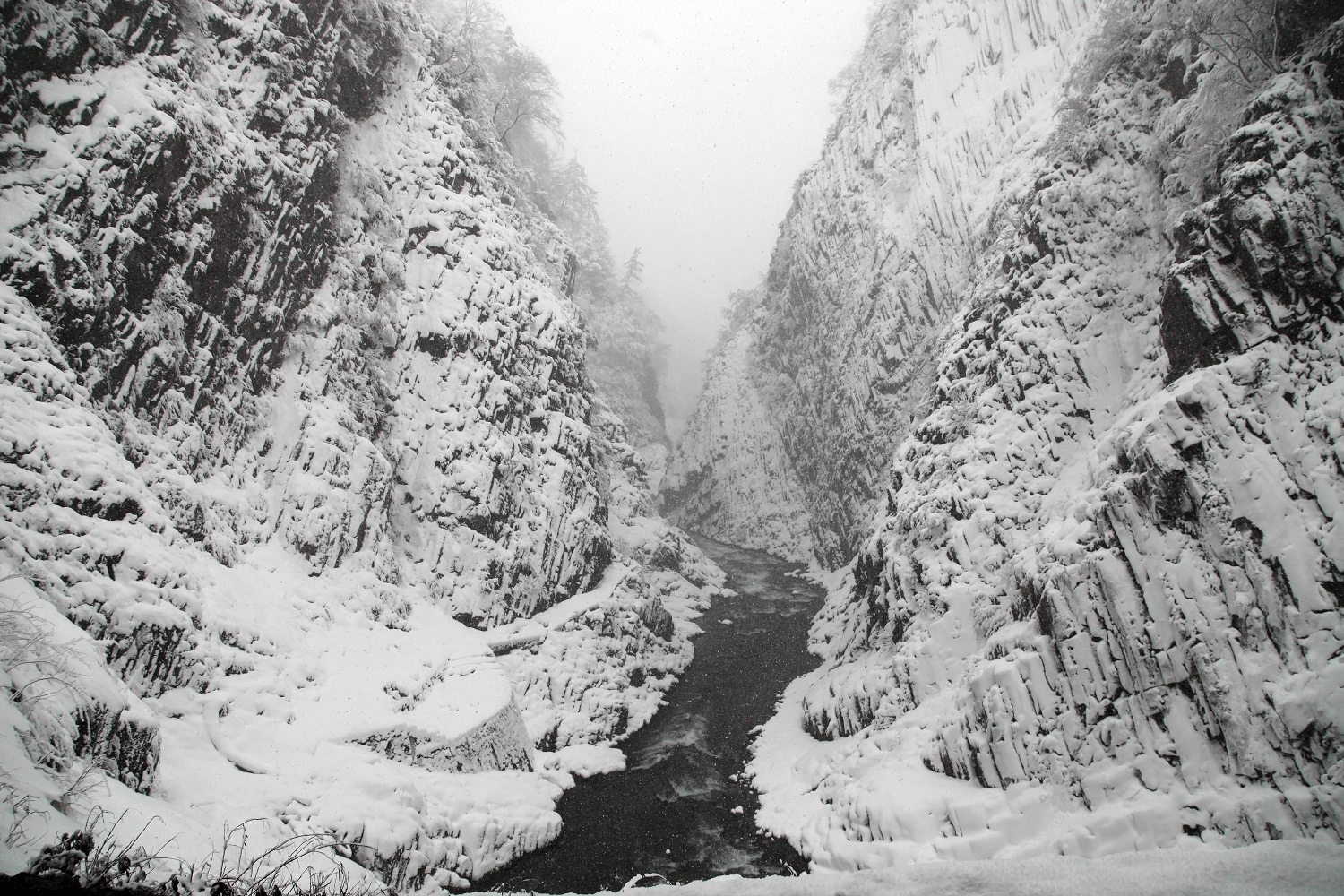
photos: Courtesy of Tokamachi Tourist Association
The Kiyotsu Gorge can be experienced through the pedestrian tunnel known as the "Kiyotsu Gorge Tunnel," transforming the entire area into an exceptional art space. Tokamachi City, along with its neighboring Tsunan Town, hosts the world's largest outdoor art exhibition held once every three years, known as the "Echigo-Tsumari Art Triennale." Additionally, the Kiyotsu Gorge Tunnel underwent renovation in 2018 and was transformed into an art installation titled "Tunnel of Light."
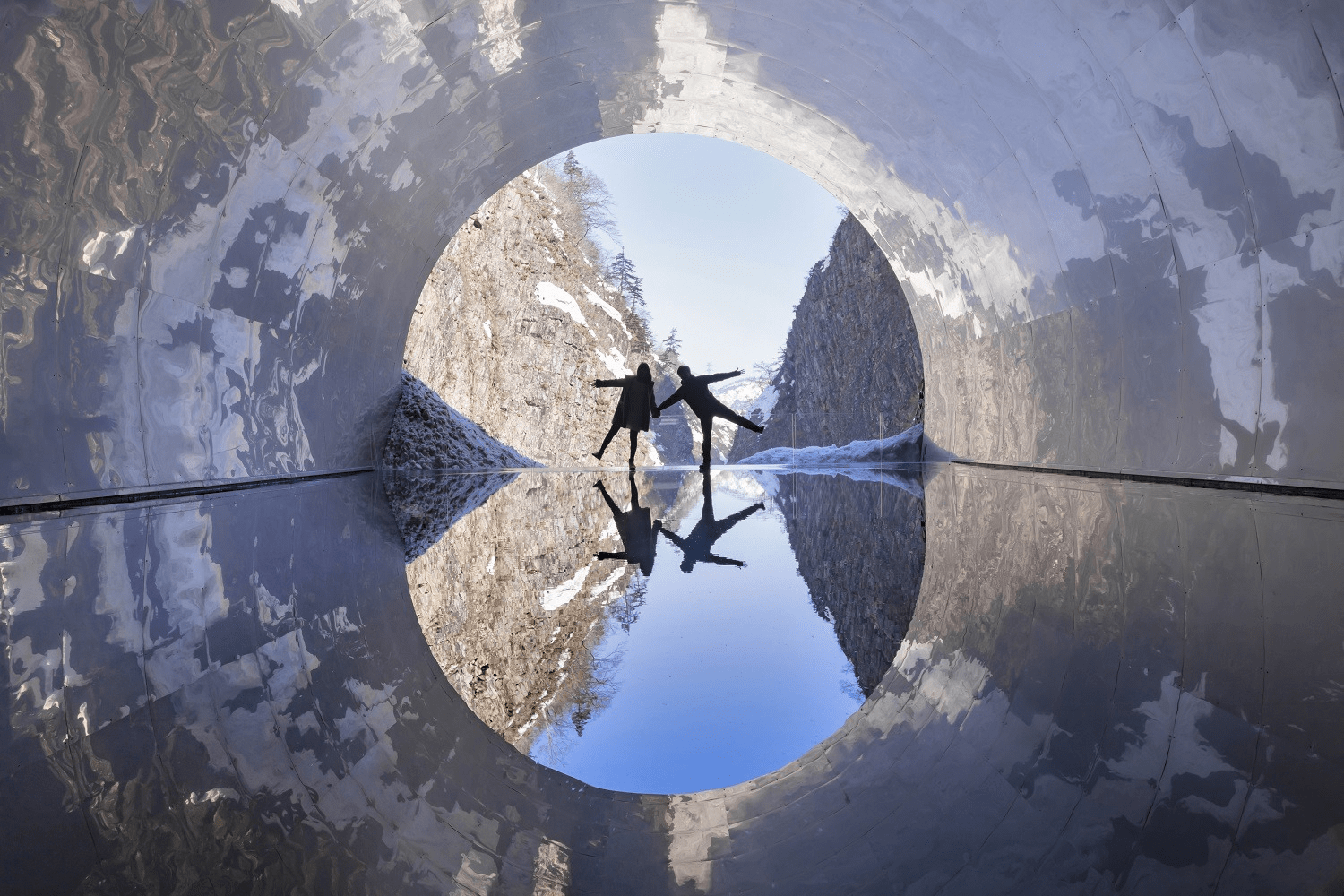
photos: Ma Yansong/MAD Architects "Tunnel of Light" (Echigo-Tsumari Art Triennale work)
The project was undertaken by the Chinese architectural group of Ma Yansong and the MAD Architects. They have created a work of art by transforming a 750-meter-long tunnel into a submarine-like structure that is isolated from the outside world, developed as a telescope looking outward, with installations at the midway observation point and at the Panoramic Station at the end of the tunnel. The space with a water mirror at the beginning of the work represents the landscape of the Panoramic Station. The second observation point creates a dynamic movement by integrating monochrome stripes with the scenery of Kiyotsu Gorge, while the third observation point reflects Kiyotsu Gorge in a convex mirror illuminated by a red backlight, creating a mysterious and warm atmosphere.
If you visit Tokamachi City to see Kiyotsu Gorge, take the opportunity to embark on an art trip and explore the numerous permanent works of the Echigo-Tsumari Art Triennial. In Tokamachi City and Tsunan Town, you can find around 200 permanent exhibitions alongside seasonal exhibitions, performances, workshops, and events.
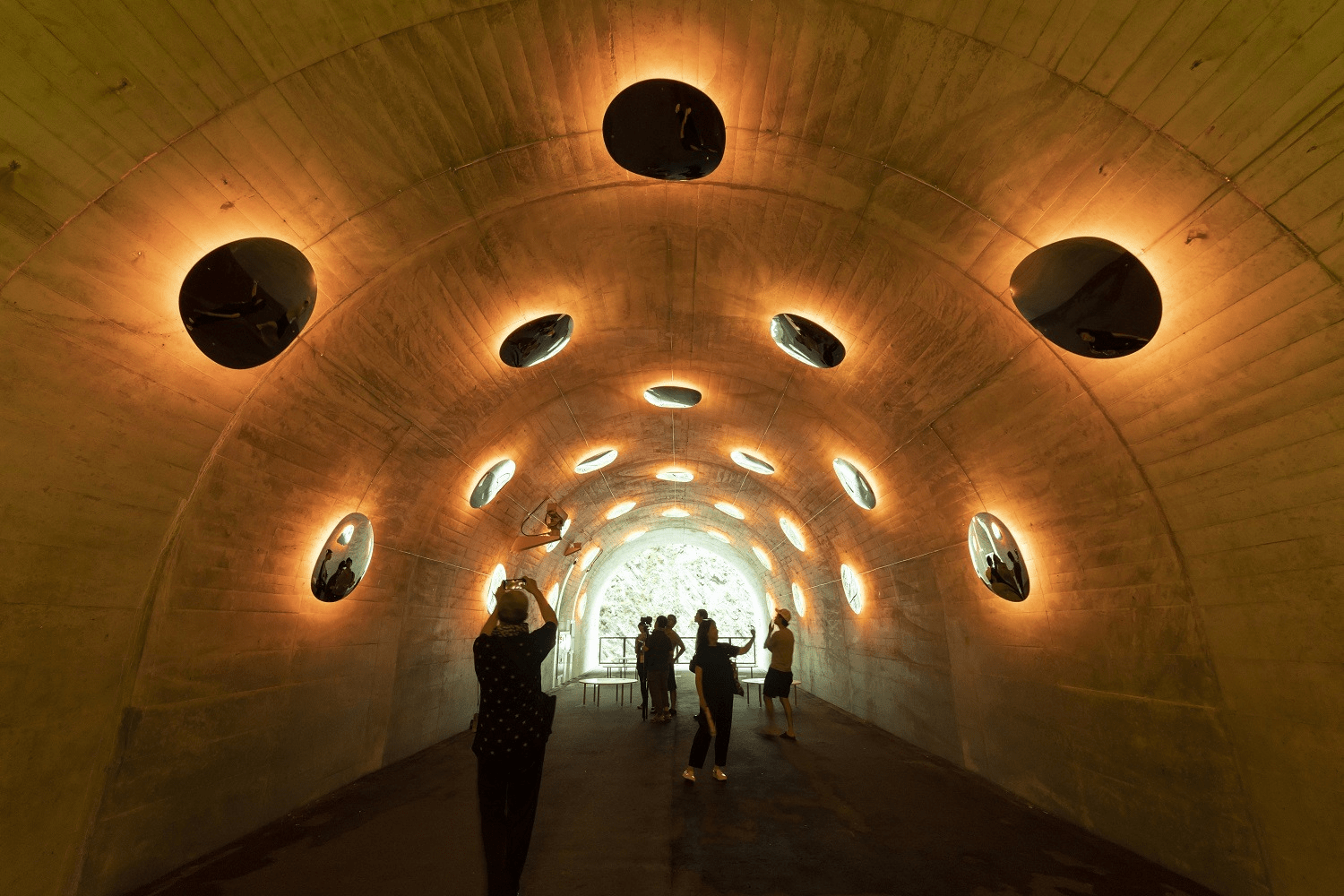
photos: Ma Yansong/MAD Architects "Tunnel of Light" (Echigo-Tsumari Art Triennale work)
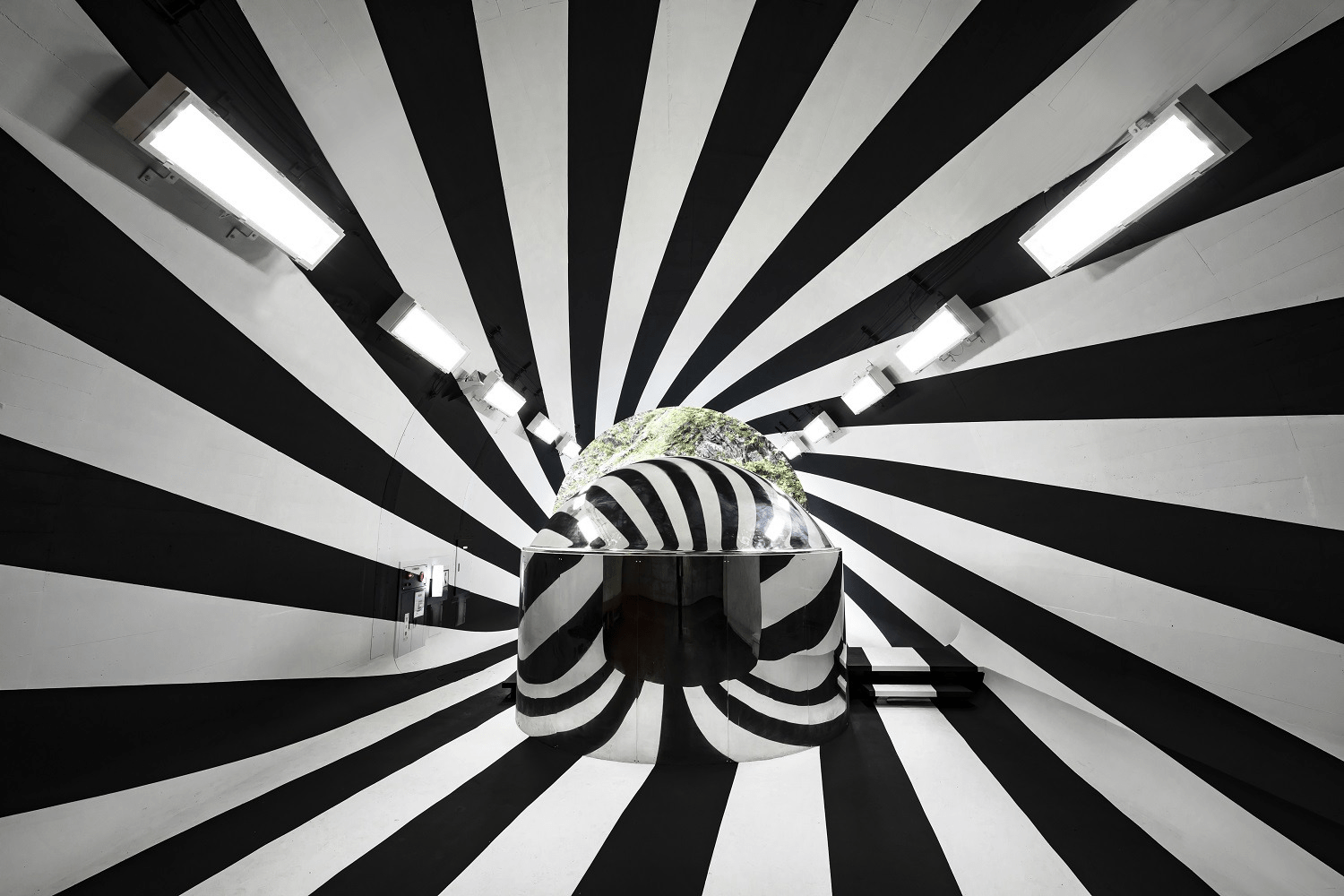
photos: Ma Yansong/MAD Architects "Tunnel of Light" (Echigo-Tsumari Art Triennale work)
It is recommended to start by visiting the main facilities that serve as the hub for exploring artworks. The "Echigo-Tsumari Satoyama Museum of Contemporary Art, MonET," located in the heart of Tokamachi City, showcases approximately 15 permanent artworks by both domestic and international artists throughout the year. The architectural design of the building was overseen by "HARA Hiroshi + Atelier Phi Architectural Drawings," renowned for their work on structures like the Kyoto Station Building. The museum's distinctive feature lies in its spatial arrangement, where a central pond is encircled by corridors with open ceilings.
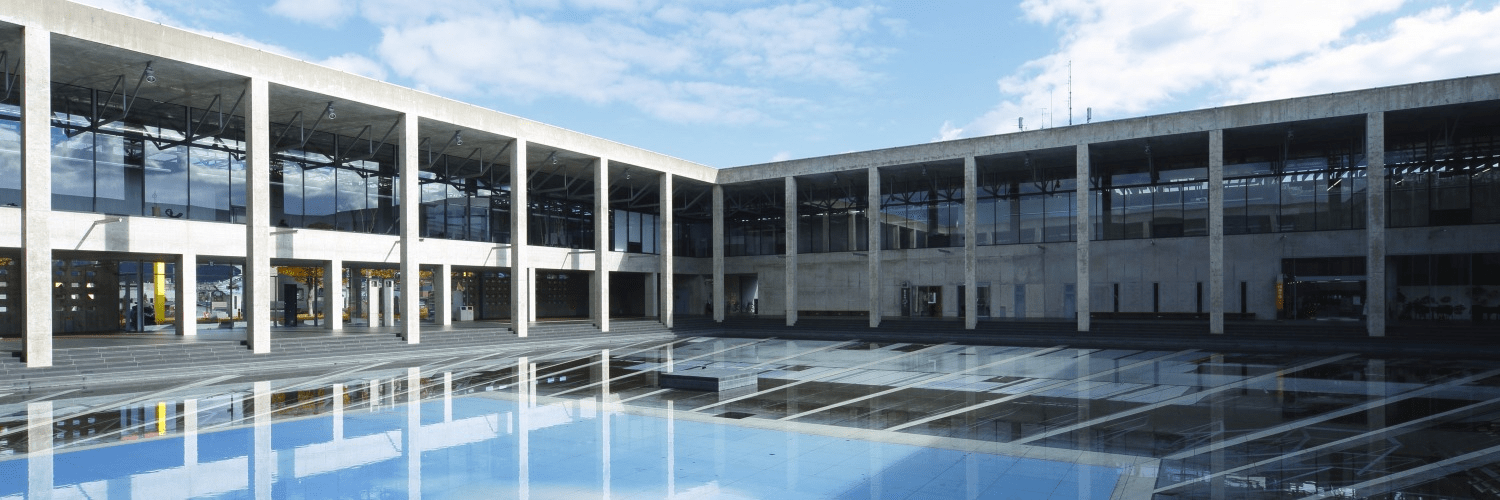
(レアンドロ・エルリッヒ 「Palimpsest: 空の池」 photo by Kioku Keizo)
In the Matsudai area of Tokamachi City, where there are many Tanada (terraced rice fields utilizing the slopes of the mountains)and Segaeda (rice fields created by changing the flow of rivers), there is a base facility called "Matsudai NOHBUTAI Field Museum" designed by the Dutch architectural group MVRDV. Inside the facility, you can appreciate artworks by world-renowned artists Ilya & Emilia Kabakov, along with works by various other artists. There is also a restaurant called "Echigo-Matsudai Satoyama Shokudo," serving delectable dishes and desserts crafted from locally sourced seasonal ingredients.
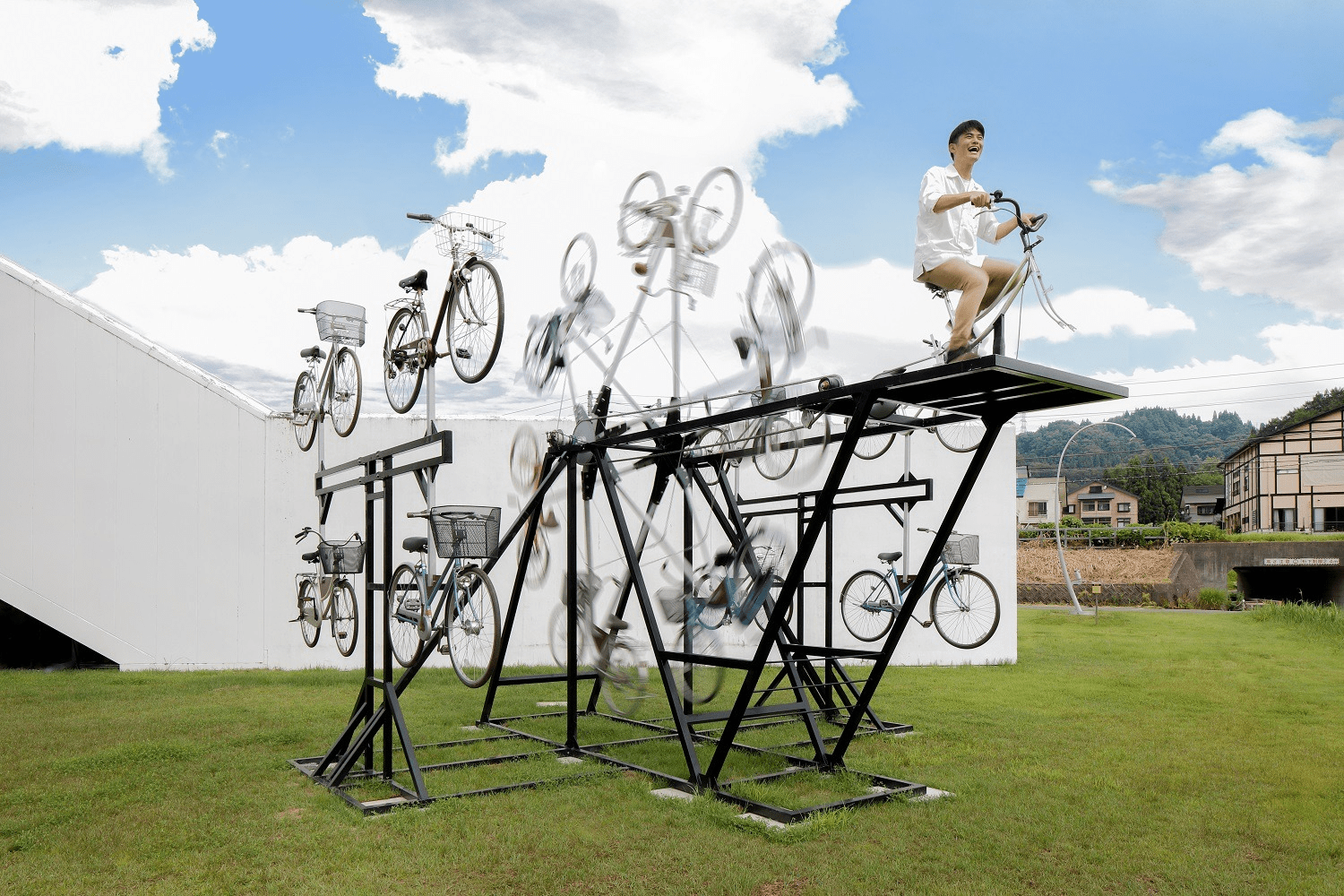
(Azuma Koichiro 「Rotating Absence”」 photo by Kioku Keizo)
It has been confirmed that the Echigo-Tsumari Art Triennale 2024 will take place from July 13th to November 10th, 2024, and last for a total of 87 days. A captivating landscape, where the nature of Satoyama (rural mountain towns)blends seamlessly with modern art, will be newly unveiled.
Check the Local Snow Conditions on the Official Website
The three locations mentioned here are situated in cold regions with heavy snowfall. Depending on the snow conditions and weather on the day of your visit, there's a chance that your intended destination may be inaccessible or experience minimal snow and ice due to the influence of a mild winter. Since these are tourist attractions related to natural winter phenomena, it's advisable to check the current situation in advance through official websites or other reliable sources before planning your visit.